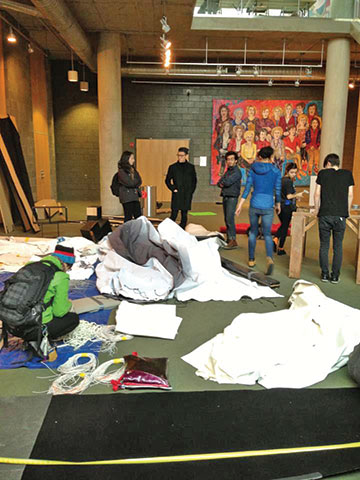Art Materials Cheap or Free
by Jack Foran

FAR collects and distributes repurposed raw materials for artists at Hi-Tem Fabrication

Two Buffalo artists with New York City connections and a truck have a unique art materials recycling project going that other artists can make use of, too.
They retrieve construction and décor materials from art and fashion shows in New York City—rather fabulous kinds and quantities of stuff that the show producers are just going to throw out anyway—and make it available to artists at prices ranging from bargain basement affordable to, in special cases, free.
“It’s unbelievable the amount of great materials they’re about to send to the dump the minute the show is over,” said Jaime Michelle Smith, a sculptor and art educator and one of the partners in the materials recycling enterprise. “We take it down and haul it away. We save them a lot of work and the garbage trucking fee.”
The other partner in the enterprise is sculptor and landscape artist and project manager for Union Concrete Construction Corporation, Carly Hill.
Some of the materials they’ve gathered are in temporary storage and available for inspection by interested possible purchasers in the attic of the Hi-Temp Building at the corner of Perry and Illinois Streets, next to the hockey arena.
Jaime points out some of the stuff. A 10-foot-by-200-foot roll of white muslin, suitable for artists’ canvas. Huge sections of previously primed muslin. Heavier canvas up to tent canvas weight. Half a ton or so of brilliant white flooring vinyl. Sheetrock-size sections of mirror-finish, vinyl-surface paneling. Other regularly available items include butcher’s paper, Plexiglas, plywood, wire of various gauges, cotton cloth.
The project is called FAR, acronym for “For Art Repurposing,” and you can see lists of materials currently available and become a member of the project—free and no obligation, but by signing in you can create a wish list of materials you’re looking for—at the www.far-nyc.com.
“The idea is sell to individual artists and to schools,” Jaime said. “At a small fraction of what they would usually have to pay for such stuff.”
But she said in some cases FAR has also donated materials to art projects that couldn’t otherwise afford them.
For example, former Americorps volunteer Robin Collier has been teaching sewing to refugee folk at the Journey’s End Refugee Services in the Tri-Main building, and is starting up classes and a business in embryo at the Foundry on Northampton Street. Eventually, she said, she hopes this project, employing refugees and neighborhood people, can produce custom-made clothing and perform other sewing services at a profit, and she specifies, an across-the-boards fair wage for everybody involved. Robin said FAR had donated a large amount of muslin material to the new project.
Jaime said she has also donated some sample boxes of miscellaneous materials to schoolteachers, who often buy materials for their classes out of their own pockets. She said the hope is that this will lead to sales, from the individual teachers or if somebody higher up in the system realizes art teachers shouldn’t have to buy the supplies for their classes.
Jaime knows whereof she speaks about teaching and teachers. She taught art for several years at Erie 1 Boces, and did other stints as a teacher and/or teaching artist in Utah, Seattle, Washington, and Shenzhen, China. She is also a certified yoga instructor.
She said the bulk of the collection of materials occurs at the end of fashion week—there are two of these a year in New York City, one in the spring and one in the fall—but also after publicity show extravaganzas by companies like Nokia and Mercedes Benz. Some of the fashion brands whose shows they have recently gleaned materials from include Calvin Klein, Michael Kors, Vera Wang, and Marc Jacobs.
“We get the materials from the show producers,” Jaime said. “Stuff they are going to get rid of anyway. They get to reduce their carbon footprint, and we find a way to reuse the materials and help artists and schools. Reuse helps everybody.”
She noted that FAR is a sponsor of the Music is Art festival this year, scheduled for September 21 and 22, and folks can stop at the FAR display to learn more about the project.
blog comments powered by Disqus|
Issue Navigation> Issue Index > v12n36 (Week of Thursday, September 5) > Art Materials Cheap or Free This Week's Issue • Artvoice Daily • Artvoice TV • Events Calendar • Classifieds |









 Current Issue
Current Issue